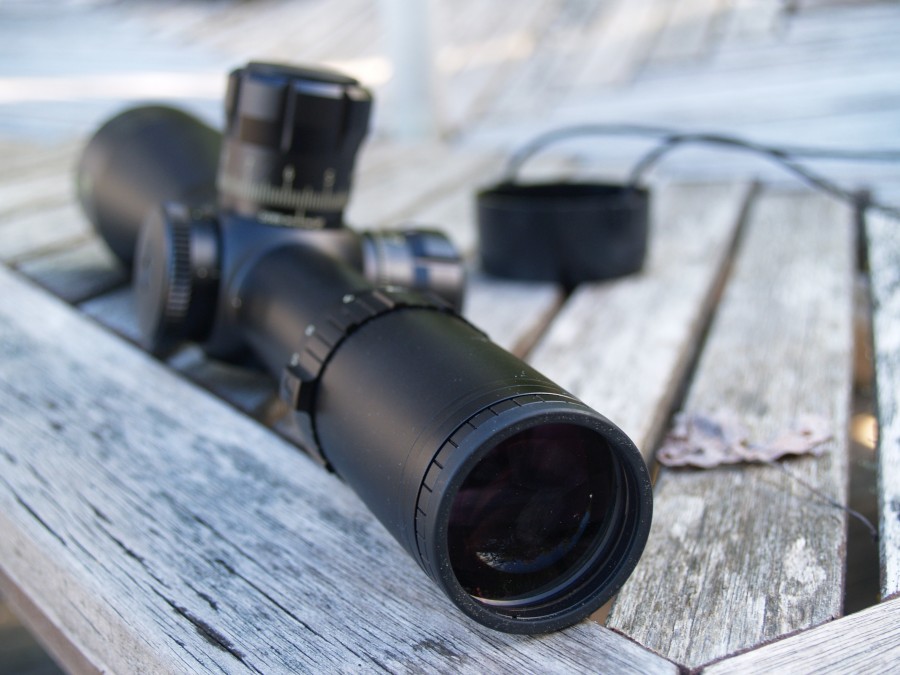
If you consider ‘long-range’ shooting to be a discipline that starts at 600 yards and ends in a neighboring county, you’ll need a hell of a rifle, of course. But just as important, you’ll need a hell of a scope to aim it with. I’ll spoil the suspense right now: the Bushnell Tactical Elite XRS is one hell of a scope. You may not need all the things it does, but for really long-range shooting, it’s just fantastic . . .
First Impressions
XRS stands for ‘Extreme Range Scope,’ and that’s exactly what it is. From its 50mm objective to its forged aluminum 34mm main tube, jumbo-sized tactical turrets and staggering 30x magnification, everything about it is huge. Including, inevitably, its $2149 MSRP.

The XRS is in back, compared to a new Burris Fullfield II 3-9x40mm in front. The Burris is no plastic-lens Chinese garbage; it’s a solid-quality scope with a 40mm objective, a 1″ main tube and a modest adjustment range from medium-low to medium magnification. These features are typical for American-style hunting scopes, but typical hunting scopes like the Burris are absolutely owned by the XRS.
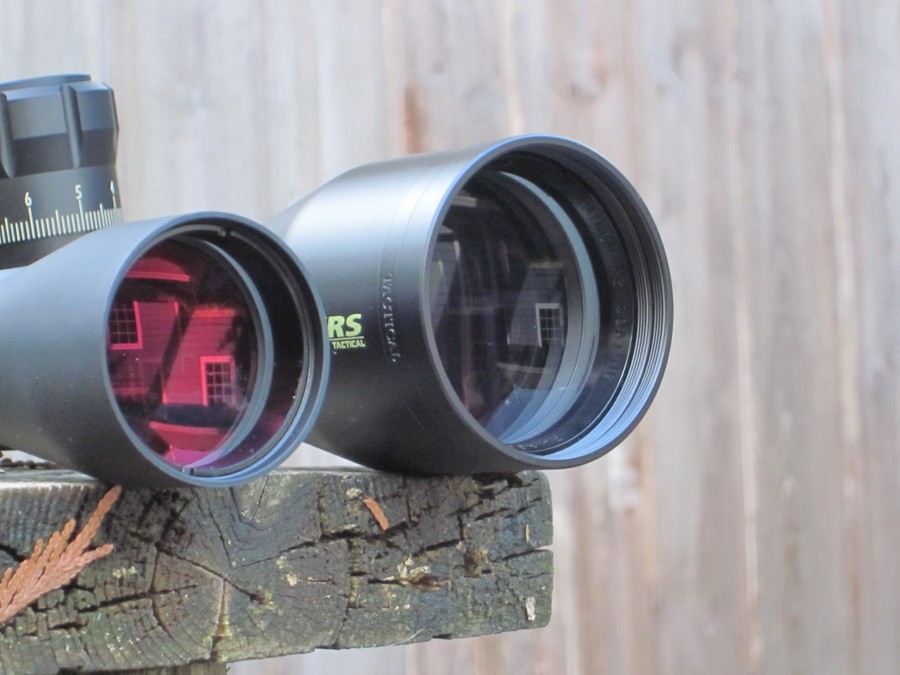
The XRS’s objective gathers more than 50% more light than a 40mm hunting scope, and this picture shows how fabulously dark those massive lenses are. The Burris’ ruby-tinted glass on the left is fully multicoated, but the XRS’s muted surface reflections are a clear hint that even fewer photons are bouncing off its glass and more of them are channeled through the optics to your waiting eyeball. The 34mm main tube of the XRS has nearly 80% more interior volume than a 1″ tube, and this accommodates larger internal optics, more complex magnification rings and sturdier reticule adjustments.
As striking as the size difference between these scopes seems in this picture, the XRS seems even bigger (and mere mortal scopes like the Burris even smaller) in person. It’s nearly fourteen and a half inches long, and weighs in at an ounce over two pounds. With the included 4-inch sunshade and some flip-up lens covers (not included) it’s even longer and heavier.
Reticule
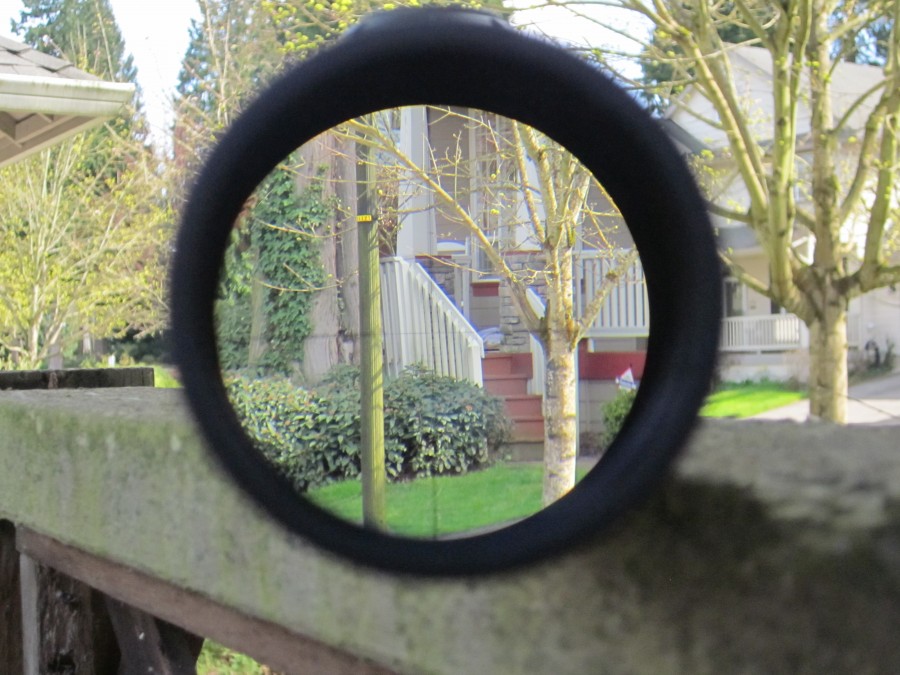
The XRS uses the G2 reticule in the first focal plane. FFP scope reticules expand as magnification increases, so range-estimating FFP scopes work properly at any magnification. When you crank the magnification all the way down to 3.5x, the detailed (but not ‘busy’) G2 reticule shrinks down to simple fuzzy crosshairs as shown here. It’s perfectly sharp in real life, but I don’t have a camera adapter for taking scope shots and I couldn’t get a properly-focused photo at low power.
Those simple crosshairs aren’t a disadvantage at short range, where there’s no need to estimate range or holdovers anyway.
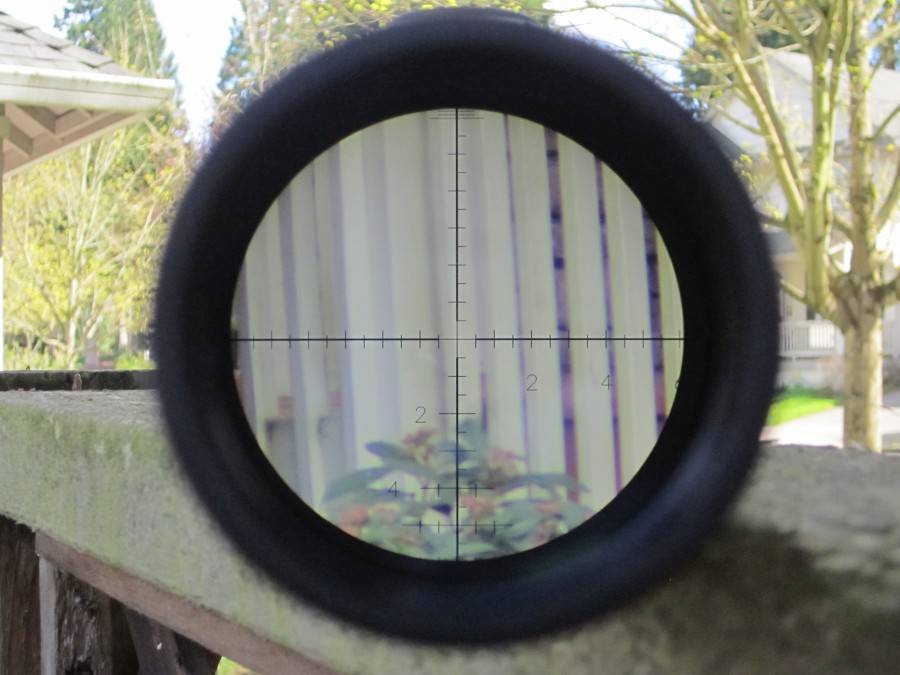
When you crank up the optics to 30x, the target zooms closer and the reticule enlarges to give you all kinds of useful subtentions. Each stadia line subtends an angle of 0.5 mils, or 1/2000 of the range to the target. I tend to forget the finer points of mil-rad range estimating and correction if I don’t practice them every few months, but I can usually remember that 1 mil equals 3.6 inches at 100 yards. If you know the size of the target you can accurately estimate the range, and vice versa.

When you’re at medium power of 12-18x, you see the whole G2 reticule in its detailed glory. If you know the dope for your rifle and cartridge, this reticule will let you hold to adjust for range and windage (at the same time) without having to adjust your turrets. Even though the XRS has quick-adjust turrets and an adjustable zero stop, you don’t always have time to dial in your dope.
(For a quick introduction to the Wide World Of Scope Reticules, Nick posted a super-informative article from Gunspec last year.)
Optics/Adjustments
The XRS is the top of the Bushnell line, and its optics have just about every feature Bushnell puts in a scope except for an illuminated reticule.
There’s a reason for that. I asked Bushnell’s chief of marketing, Tom Fuller, about the technical aspects of illuminated FFP reticules, and he clued me in. FFP reticules are extremely challenging to illuminate consistently, because the brightness of the reticule diminishes with the inverse square of the magnification.
For those who didn’t pay attention in geometry, this means that an illuminated FFP reticule is more than 25x as bright at 30x as it would be at 4.5x. Either that reticule will blind you at 30x, or you won’t be able to see it at all at 4.5x. There are no really good choices here, which is why the XRS doesn’t have an illuminated reticule.
The XRS features fully multicoated optics. Some scopes advertise ‘fully coated’ optics (meaning that every glass-to-air surface is coated with at least one coating) and some advertise ‘multi-coated’ optics (meaning that at least some glass-to-air surfaces are multi-coated). The XRS, as befits its price range, doesn’t play any word games to leave you guessing: every glass-top-air surface is coated with multiple layers of magnesium flouride and the rest of Bushnell’s proprietary recipe of Ultra Wide Band coatings for decreased surface reflection, maximum brightness, and color correction.
Then entire scope is purged and filled with inert argon gas to prevent internal fogging, and the objective and ocular lenses get Bushnell’s water-repellent coating called Rainguard HD. Our Pacific Northwest weather gave this coating more of a test than we’d really wanted, when our quarry shooting day was deluged by about an inch of rain or snow per hour.
The downpour almost swamped our shelters, and at times we couldn’t see our 50-yard Shoot-N-See target. The XRS and its rifle (as well as its shooter) came home thoroughly soggy, but the scope totally ignored it. The water beaded right off the lenses when we were shooting in the rain, and when the scope was finally dry I couldn’t even tell that it had ever been wet. No lens cleaning was needed at all.
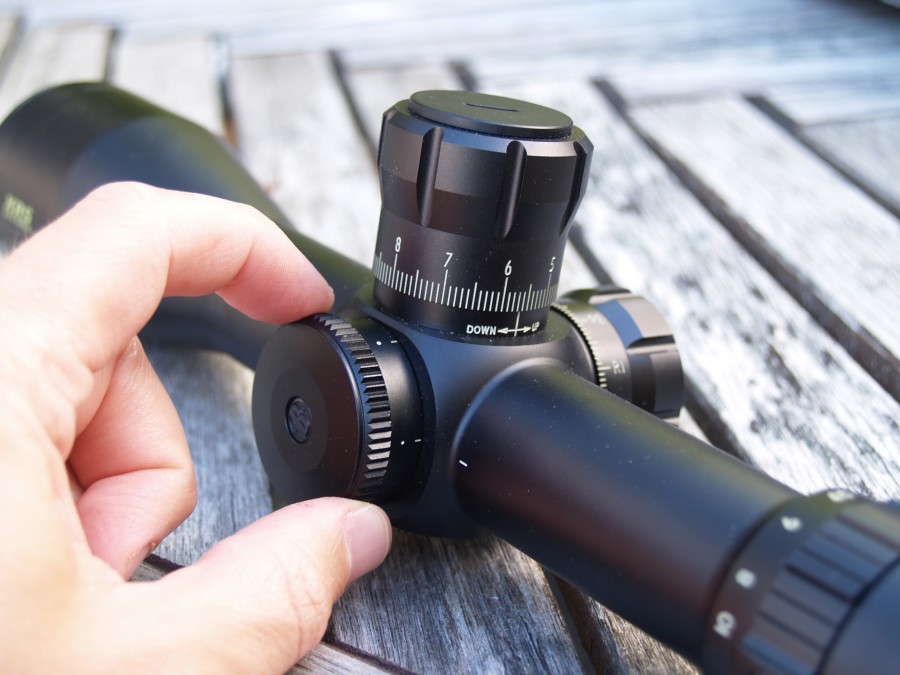
The XRS features side-adjustable focus and parallax, from about 15 yards to infinity. The dots on the adjustment dial are not indexed, except for an ‘inifity’ symbol that’s hard to tell from an 8. The focus dial is on the left side of the turrets, and if you’re shooting from a rest or bipod it’s easily adjusted without removing your eye from the target.
The eyepiece also has a quick-focus diopter ring, to adjust for farsighted or nearsighted shooters. This tends to be a ‘set it and forget it’ adjustment, but the adjustments were smooth and stable.
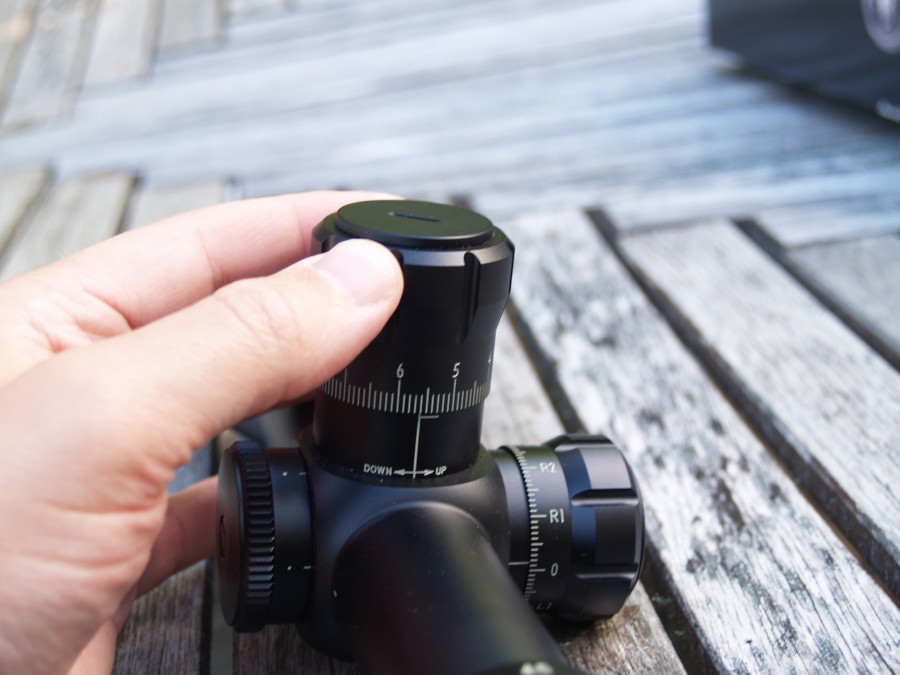
It would be nice if your rifle’s zero was also a ‘set it and forget it’ affair, but different loads, ranges and atmospheric conditions make this an impossibility. Keeping this in mind, Bushnell gave the XRS the niftiest set of tactical turrets I’ve ever used. They’re big and precise, and they lock in the down position so the reticule doesn’t move unless you pull up the caps and make it move.
The turrets are graduated in tenths of a mil, and each twist of the dial gives you ten full mils of adjustment. From top to bottom you get about 28 mils of elevation adjustment, and the turrets are indexed so you’ll be able to return the reticule to center for zeroing on a new rifle.
The XRS also has an adjustable zero-stop. This is a handy (but complex) feature that lets you instantly dial your elevation back down to your chosen zero, instead of having to refer to your dope sheet and count your clicks back to where (you hope) your zero was. We didn’t use it during firing testing with the Accuracy International, but I followed the directions and set it when the scope was unmounted.
During our testing, the XRS gave precise and repeatable point of impact adjustments that corresponded nearly exactly to their advertised 1/10 mil values. When I need to raise my POI by a hair over 10″ at 300 yards, I remembered my mil math and dialed in another 1.0 mils of elevation.

The precision of the XRS adjustments was demonstrated with my next group, this 300 yard cloverleaf at perfect elevation. After this we cranked it 0.2 mils left, and we were in the money for the rest of the day.
The only ergonomic gripe I have with the XRS is a rather small one: the power ring was too stiff to adjust quickly.
How Does It Shoot?
Two words: bright and clear. At whatever magnification you choose, this will be among the brightest scopes of that magnification you’ll ever find. You probably won’t shoot the XRS very often at 4.5x, but you might need to keep your sunglasses on if you’re aiming into a bright target field. In poor light, a scope this bright can give you several extra minutes of usable twilight for hunting, but be sure to mind the ‘legal sunset’ in your jurisdiction.
The XRS continued to impress us at higher powers. Smaller scopes usually have me squinting and straining at 16x as their brightness and exit pupil diminish to uselessness, but the XRS has the size and clarity to make good use of its eye-popping 30x top end. Even at max power, it still provides a useful 1.7mm exit pupil with enough brightness to resolve targets at range.
I am not blessed with exceptional eyesight (quite the opposite, sadly) but the big Bushnell helped me get consistent 1.5″ groups at 300 yards with a supremely accurate rifle and I cannot imagine any scope doing better than that.
Mounting Considerations

Mounting this big glass requires tall 34mm scope rings and 6.4 inches of empty rail space. When you’re mounting a top-grade scope on a top-grade rifle, it doesn’t pay to be penny-wise and pound-foolish. Talley Products kindly sent us their outstanding Tactical tall scope rings (pictured here), which bolted on with no drama and held the XRS with absolute precision.
$210 isn’t chump change for scope rings, but you get what you pay for. These Talley rings required no thread-lock compound, and they fit the scope so perfectly that they left no mark on the scope whatsoever, even after several weeks and several hundred rounds downrange. I’m grateful for the loan from Talley, and they only reason I’m not buying them and keeping them myself is that I don’t have a 34mm scope to use them with.

There’s one more thing I should mention about mounting a big scope like the XRS: if you want to take full advantage of its 30x magnification, your rifle needs to be set up for an absolutely consistent cheek weld. Preferably this means a stock with a sturdy adjustable cheek rest like this one on the AX-308, but you’ll definitely need something to put your eye in exactly the same position from shot to shot. My own Remington 700 PSS wears a Blackhawk lace-on cheek rest. This $20 solution works well for my 16x scope, but I wouldn’t depend on it at nearly twice that magnification.
Conclusion
The Bushnell XRS 4.5-30×50 is a specialized scope. It’s got a ton of well-executed features that let it do something that few scopes can do better: put lead on target at unbelievable distances.
The only ‘cons’ about this optic are its size and its price, and neither of those are really negotiable for extreme-range shooting. We didn’t get to do any truly ‘extreme’ range shooting with the XRS, but I hit the longest shot of my life with a lower-powered Bushnell HDMR using the same G2 reticule.

The smaller 3.4-21x50mm HDMR had me ringing this 950-yard gong consistently with an Accuracy International .338 Lapua. After many shots, I even hit the tiny speck in the treeline at up-10, right-7: a 10″ gong at 1140 yards. (This picture was taken through a 10x spotter, not the scope itself.)
If you’ve got the rifle that will let you connect at these kinds of ranges, you’ve probably got the cash to afford a worthy scope like the Bushnell XRS. It’s not cheap, but it is outstanding.
Specifications:
Type: 4.5-30 power, 50mm objective, side-adjust focus/parallax
Reticule: G2, first focal plane
Weight: 37 oz.
Length: 14.5″
Turrets: Locking tactical, with adjustable zero stop
Adjustments: .1 mil per click, 10 mils per turn
Tube: 34mm
MSRP: $2149
Ratings (out of five stars)
Optical Clarity * * * * *
Outstanding sharpness at all magnifications.
Brightness * * * * *
The big objective lens and fully multi-coated optics give you all the photons the laws of physics allow.
Controls/Ergonomics * * * * 1/2
The turrets gave precise, repeatable POI adjustments. Subtract 1/2 star for a very stiff power ring.
Fit And Finish * * * * *
No flaws, toolmarks, scratches, or imperfections of any kind.
Overall Rating * * * * *
A worthy optic for any precision rifle, in any caliber, at any practical range.


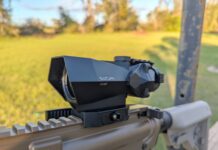


Might have missed it in the lengthy review, but where is it made?
west koreastan. durrrrrrrr.
The glass is from Japan. I don’t know where final assembly is, but I’m assuming it’s either there or here. Probably there.
I’d be interested in Nightforce’s take on scope illumination. They have illuminated reticules on their high end scopes.
For that price you can get a top end Leupold or Nightforce. It’s nice to see other companies breaking into the premium LR scope bracket, but the pricing is still prohibitive to the majority of shooters. It would be good to see quality LR scopes in the $1k range.
[q] For those who didn’t pay attention in geometry, this means that an illuminated FFP reticule is more than 25x as bright at 30x as it would be at 4.5x.[/q]
How about a potentiometer based brightness adjustment as you dial up the power it dials down the brightness? $3 worth of parts.
I do not understand why Bushnell would even be a consideration if you have that kind of cash to drop on a scope. It looks nice, and the technical specs sound good, but is it really in the same quality as U.S Optics, Nightforce, etc, etc, etc?
My thought exactly. Other than a slightly wider scope tube, they don’t seem to offer much to justify the price for a Bushnell.
It’s certainly worthy competition for Nightforce and U.S. Optics, etc. This ain’t your daddy’s Bushnell, that’s for sure. They have really stepped up their game big time.
They are really working hard to change their image with their higher end stuff. There will always be people that remember them as a K-Mart brand and sneer, but they’re not like that anymore.
Well I bought one last week for my GAP 10, I haven’t had a chance to shoot the rifle yet let alone sight in the scope so it’s good to have confirmation that someone else thought it was a great optic as well.
I really wanted a nightforce beast but since its not out yet I figured this would let me have some fun and practice until it is available, but hey I might just keep it
And if you’re looking to sell it, Joe Grine might be interested!
Nice review. A very impressive piece, with an impressive range of magnification. But for that price, US Optics is about two miles from my house in Brea, CA. All things being relatively equal, I’d take the optics made in the US. However, I don’t have $2,000 plus for a new scope, so a lessor offering will definitely be in the works.
If TTAG has a Vortex Viper PST review, I’d be very interested.
Nice review, great scope. Unfortunately a scope at that price is way above what I’m willing to fork over for decent glass.
Check out the Millett LRS in 6-25 x 56. It has a 35mm tube and comes with the sun shade and rings. MSRP is around 800 but I got mine thru optics planet for around 500 bucks. It’s been taking a pounding on my Big Mac for a few years. No hiccups.
Has 120 minutes of elevation, so thousand yard work is easy.
Just FYI.
Every time I see an expensive scope review and the comments that accompany it, I am reminded of something my Long Range Scoped Rifle instructor said. “Americans buy expensive guns but tend to cheap out on the glass while Europeans buy expensive scopes but cheap out on the guns.” Something that bears thinking. My custom built .300 Win Mag ran about $3,500 or so all told and currently has a more modest Bushnell offering that ran about $900. Once capital frees up somewhat, I’ll be in the market for a $2K scope for it and move the Bushnell to my M1A.
The whole argument reminds me of my earlier days as an audiophile – Your speakers should match your receiver. If you are going to spend $2K on a receiver, don’t cheap out with $500 speakers.
I have no problem (funds permitting) putting a good scope on my rifle, and let’s face it, there is nothing in the sub-$500 range that belongs on it. At the end of the day, if you can’t see your target, you can’t hit it.
I’ve been down the road of the cheap scopes and I have not found anything under five Benjamins that works worth a damn on a true long range rifle. Remember that Chris tested this scope atop an Accuracy International Rifle. Expensive Glass + Expensive Gun means you nail the crap out of what you are shooting at when you go north of 1,000 yards.
All that said, I have a real hard time ponying up $2K for a Bushnell when the same capital buys me a Nightforce that has second to none QA testing and is used by the guys who really understand the value of a good scope – ie Navy Seals, etc. Price this Bushnell at $1499 and you can sign me up. At $2K, I’ll get the Nightforce. I don’t need First Focal Plane because I have a decent rangefinder that is good out to 1,600 yards, which is far further than I trust my .300 Win (or my skills) to shoot.
Couple of thoughts: when you say: “I don’t need First Focal Plane because I have a decent rangefinder that is good out to 1,600 yards” The FFP with Mil/Mil Reticle is nice to make your corrections when you see your POI- something your rangefinder wont help you with. It was so easy to simply dial in corrections without doing any math, or having to worry about only being on the “correct” magnification setting. Also, I viewed the XRS side by side with a Nightforce and I didn’t see any difference. The Bushnell is going to save you some $$$ over a NF or US Optics. I think you have to view them side by side before you judge.
My step dad taught me to shoot long-range. He told me there is a rough rule for buying scopes for a rifle. “You will spend as much on the scope as you did the rifle if you wanna get the best out of it.” At almost 70, he still out shoots me with a rifle and a shotgun. I have caught up with handguns, but I think a lot of that has to do with small sights and deteriorating eye sight and arthritis.
[quote] All that said, I have a real hard time ponying up $2K for a Bushnell when the same capital buys me a Nightforce that has second to none QA testing and is used by the guys who really understand the value of a good scope – ie Navy Seals, etc. [/quote]
Looks like the XRS is turning heads, especially SEAL’s heads. Not only are they transitioning over to .338 Lapua Mags, but they will be topped with Bushnell XRS 4.5-30 X 50 with the G2 reticle.
Great review! it was one of the main sources of information that i used to decide on buying one of these scopes! (as reviews and information is limited on a new scope such as this).
I picked up one with the H-59 reticle.
One Issue i have, is that the Scope will not focus at 50 metres (55 yards) – which is our local indoor range. I have spoken to shop i bought it from and they tested another scope and found the same. They said it comes good at around 55-60m, They are also waiting on a response from Bushnell regarding the spec.
Are you able to confirm your comments on the XRS having a focusing range upwards of 15 yards to infinity?
Kent, I have an XRS 4.5-30 with the G2 reticle and mine has no problem focusing at under 15 yds.
Morris,
Excellent, thankyou so much for the quick reassurance.. Assuming the H59 ret. doesn’t make a difference, it means my scope is a dud.
I am actually quite happy if that is the case, as i am otherwise ecstatic with the scope, i really wanted it to do 50m +
Sorry, one more thing.. at 15 yards, could you get the target image and the reticle to focus at the same time?
as luck would have it the scope is off the rifle, I just pulled it out of the safe and can get the image in focus at 12 yds and the reticle, but only on 4.5, if I turn up the magnification at 12 yds the reticle starts to blurr. Anything less than the 12 yds though and I think the reticle will be slightly out of focus
I have this scope and luv it, with the g2 reticle. After using this scope my smaller scopes feel like im using a red dot sight. The downsides of this scope is 1. Its heavy and 2. It doesnt have the adjustment range of the competition. I got mine several months ago from milehighshooters for 1200 new! It is by far the best scope on earth at that price imo. If u have a tighter budget, the swfa 3-15 for 500 to 600 is a great deal, a scope i own and highly recommend, if u need an even cheaper scope everyone luvs the 250 dollar primary arms 4-14 ffp
I know this is an old review/thread, but I just ran across it and thought I would toss in my thoughts for ppl who may be looking at this now-
I own the 3.5-21 version of this scope with all the bells and whistles, cost me $1570 from Midway USA.
I love it! Glass is very clear, all the controls work flawlessly. For those looking to get a scope like this closer to the $1000 mark, they also offer the elite tactical 3.5-21 power with the 34mm tube without the zero stop for about $1200. if that is still too much, you can get it in a 30mm tube in a 6-24 power for $800. all with the G2 reticule.
One more thing to note, is that while the $1570 I shelled out for this, is a lot to pay for a scope, you cannot touch a similar nightforce or US optics for under $2500 new.(FFP G2 style reticule and +20 power magnification. BTW-used market is completely subjective and not really applicable here since we are talking about new.) That being said, even at close to $1600, you get a lot for your money.
The scope reviewed here is selling right now for $1800-$1850 at Dvor.com and Midway USA.(about $400 below listed price on this article.)
Hope this is helpful to someone.
.
Hi Scott, I am about to pick up the XRS for $1890 here in Australia (usually $2500-$2700), which is a bargain for here as we get ripped off heavily here all this guns…..especially firearms makes me cry when i see prices in America. And Nightforce….something same spec as bushnell, nothing for under $3-4000. Anyway bushnell/Nightforce come out of same factory in Japan. US Optics here in Australia….. $4-4500. I also own the Bushnell Tactical ERS 6-24×50 with the G2 reticle and its sensation….nothing wrong with that!!
@Luke Heffernan:
Yes – I also found this scope at MagnumSports (AU$1890).
Did you get it ? How is it ? No problems ?
I am asking – because I am about to order it 🙂
Thanks for the info – if any is forthcoming 🙂
Having read this I believed it was rather enlightening.
I appreciate you spending some time and energy to put this content together.
I once again find myself personally spending a lot of time
both reading and leaving comments. But so what, it was still worthwhile!
Comments are closed.